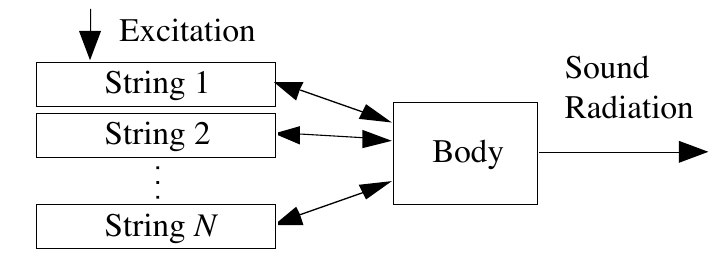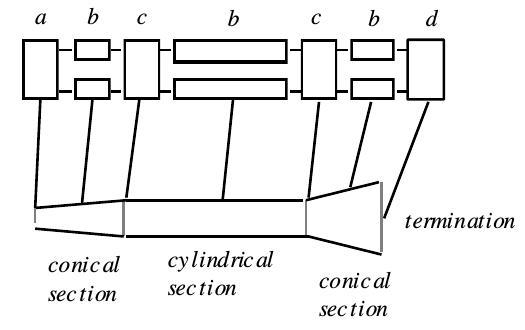More advanced physical models can be designed,
based on the principles explained in the previous sections.
Resonant Bodies & Coupling
The simple lowpass filter in the example can be replaced
by more sophisticated models.
For instruments with multiple strings,
coupling between strings can be implemented.
Model of a wind instrument with several waveguides,
connected with scattering junctions (de Bruin, 1995):
References
2019
- Stefan Bilbao, Charlotte Desvages, Michele Ducceschi, Brian Hamilton, Reginald Harrison-Harsley, Alberto Torin, and Craig Webb.
Physical modeling, algorithms, and sound synthesis: the ness project.
Computer Music Journal, 43(2-3):15–30, 2019.
[details]
[BibTeX▼]
@article{bilbao2019physical,
author = "Bilbao, Stefan and Desvages, Charlotte and Ducceschi, Michele and Hamilton, Brian and Harrison-Harsley, Reginald and Torin, Alberto and Webb, Craig",
title = "Physical modeling, algorithms, and sound synthesis: The NESS project",
journal = "Computer Music Journal",
year = "2019",
volume = "43",
number = "2-3",
pages = "15--30",
publisher = "MIT Press One Rogers Street, Cambridge, MA 02142-1209, USA journals-info\textasciitilde …"
}
2004
- Chris Chafe.
Case studies of physical models in music composition.
In Proceedings of the 18th International Congress on Acoustics. 2004.
[details]
[BibTeX▼]
@inproceedings{chafe2004case,
author = "Chafe, Chris",
title = "{Case studies of physical models in music composition}",
booktitle = "{Proceedings of the 18th International Congress on Acoustics}",
year = "2004"
}
1995
- Vesa Välimäki.
Discrete-time modeling of acoustic tubes using fractional delay filters.
Helsinki University of Technology, 1995.
[details]
[BibTeX▼]
@book{valimaki1995discrete,
author = "Välimäki, Vesa",
publisher = "Helsinki University of Technology",
title = "{Discrete-time modeling of acoustic tubes using fractional delay filters}",
year = "1995"
}
- Gijs de Bruin and Maarten van Walstijn.
Physical models of wind instruments: A generalized excitation coupled with a modular tube simulation platform*.
Journal of New Music Research, 24(2):148–163, 1995.
[details]
[BibTeX▼]
@article{de1995physical,
author = "de Bruin, Gijs and van Walstijn, Maarten",
journal = "Journal of New Music Research",
number = "2",
pages = "148–163",
publisher = "Taylor \\& Francis",
title = "{Physical models of wind instruments: A generalized excitation coupled with a modular tube simulation platform*}",
volume = "24",
year = "1995"
}
1993
- Matti Karjalainen, Vesa Välimäki, and Zoltán Jánosy.
Towards High-Quality Sound Synthesis of the Guitar and String Instruments.
In Computer Music Association, 56–63. 1993.
[details]
[BibTeX▼]
@inproceedings{Karjalainen1993towards,
author = "Karjalainen, Matti and Välimäki, Vesa and Jánosy, Zoltán",
booktitle = "{Computer Music Association}",
pages = "56–63",
title = "{Towards High-Quality Sound Synthesis of the Guitar and String Instruments}",
year = "1993"
}
1992
- Julius O Smith.
Physical modeling using digital waveguides.
Computer music journal, 16(4):74–91, 1992.
[details]
[BibTeX▼]
@article{smith1992physical,
author = "Smith, Julius O",
journal = "Computer music journal",
number = "4",
pages = "74–91",
publisher = "JSTOR",
title = "{Physical modeling using digital waveguides}",
volume = "16",
year = "1992"
}
1971
- Lejaren Hiller and Pierre Ruiz.
Synthesizing musical sounds by solving the wave equation for vibrating objects: part 1.
Journal of the Audio Engineering Society, 19(6):462–470, 1971.
[details]
[BibTeX▼]
@article{hiller1971synthesizing,
author = "Hiller, Lejaren and Ruiz, Pierre",
title = "Synthesizing musical sounds by solving the wave equation for vibrating objects: Part 1",
journal = "Journal of the Audio Engineering Society",
year = "1971",
volume = "19",
number = "6",
pages = "462--470",
publisher = "Audio Engineering Society"
}
- Lejaren Hiller and Pierre Ruiz.
Synthesizing musical sounds by solving the wave equation for vibrating objects: part 2.
Journal of the Audio Engineering Society, 19(7):542–551, 1971.
[details]
[BibTeX▼]
@article{hiller1971synthesizing2,
author = "Hiller, Lejaren and Ruiz, Pierre",
title = "Synthesizing musical sounds by solving the wave equation for vibrating objects: Part 2",
journal = "Journal of the Audio Engineering Society",
year = "1971",
volume = "19",
number = "7",
pages = "542--551",
publisher = "Audio Engineering Society"
}


